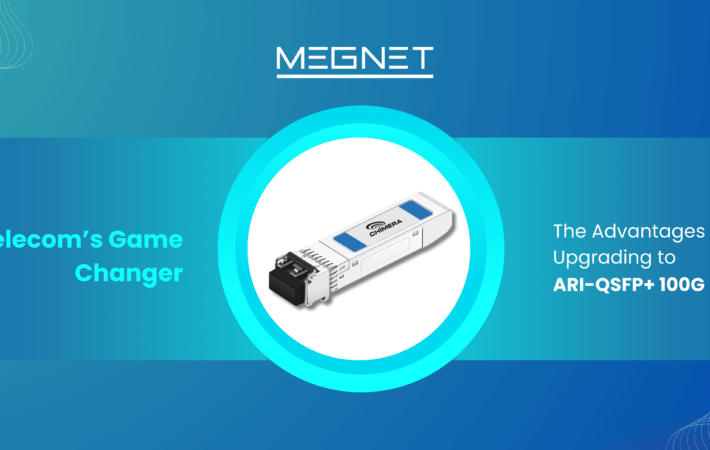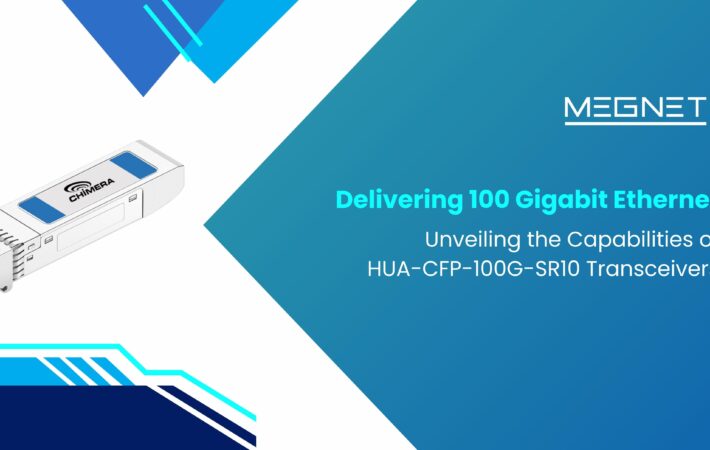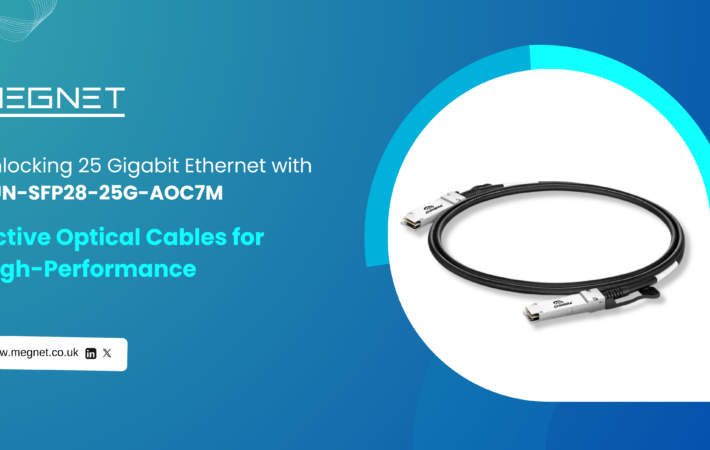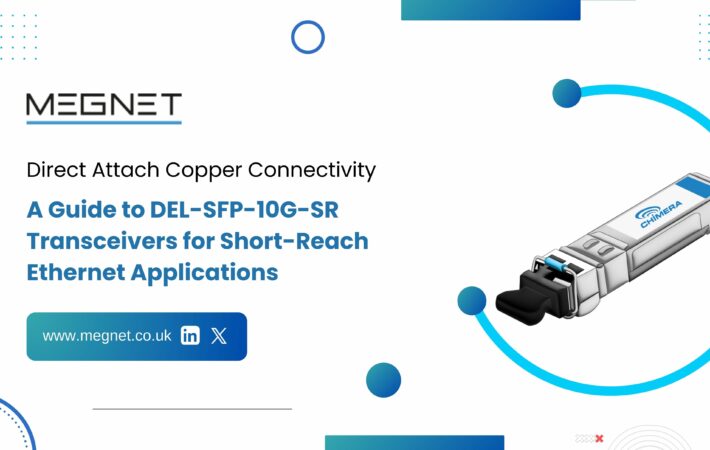
Introducing Cisco’s 100GBASE-SR SWDM4 Bi-Di
In the ever-evolving realm of data centres, network performance has become a critical factor in figuring out operational efficiency and success. As data traffic continues to surge exponentially, traditional network architectures strain to keep pace, leading to bandwidth bottlenecks that hinder application performance, user experience, and overall business productivity. To address this pressing challenge, Cisco has introduced a revolutionary optical transceiver technology, the 100GBASE-SR SWDM4 Bi-Di, poised to reshape the landscape of data centre networking.
Expanding Cisco’s BiDi portfolio
The Cisco QSFP-100G-SR1.2 BiDi is a parallel Quad Small Form-factor Pluggable (QSFP28 (Quad Small Form Factor Pluggable 28)) Bi-Direction optical module that supports 100 Gbps bit rates. The module integrates four host electrical data into two optical lanes over a 2-fibre duplex LC (Lucent Connector) optical multi-mode fibre. The QSFP (Quad Small Form Factor Pluggable) 100G SR1.2 BiDi operates 50Gb PAM4 (Pulse Amplitude Modulation 4) channels, for a total aggregate bandwidth of 100Gb. PAM4 technology enables 50Gb data rate with signalling at 25Gbaud rates. Reversely, on the receiver side, the module de-multiplexes 2 sets of optical input signal and converts them to 4 channels of electrical data. An optical fibre ribbon cable with an LC connector can be plugged into the QSFP28 module. The QSFP 100G SR1.2 BiDi is compliant to IEEE802.3bm 100GBASE-SR4.

100GBASE-SR SWDM4 Bi-Di: A Paradigm Shift in Optical Transceiver Technology
The 100GBASE-SR SWDM4 Bi-Di stands for a significant leap forward in optical transceiver capabilities, offering a multitude of advantages over its predecessors:
Unprecedented Bandwidth: With a staggering data rate of 100 Gbps per link, the 100GBASE-SR SWDM4 Bi-Di delivers four times the bandwidth of traditional 25GBASE-SR optical transceivers, effectively cutting bandwidth bottlenecks and empowering data centres to handle the ever-increasing demands of modern applications.
Reduced Latency: Latency, the time it takes for data to travel across a network, plays a crucial role in application responsiveness and user experience. The 100GBASE-SR SWDM4 Bi-Di boasts an exceptional latency of less than 1 nanosecond, significantly lower than traditional optical transceivers, ensuring seamless data transfer and minimising delays.
Enhanced Energy Efficiency: Power consumption is a critical consideration in data centres, as excessive energy usage can lead to increased operating costs and environmental impact. The 100GBASE-SR SWDM4 Bi-Di consumes up to 50% less power than traditional optical transceivers, promoting energy efficiency and reducing environmental impact.
Simplified Cabling Infrastructure: Traditional optical transceivers often require multiple fibre pairs to send data in both directions, leading to complex cabling infrastructures that can be costly and difficult to manage. The 100GBASE-SR SWDM4 Bi-Di uses a single fibre pair for bi-directional data transmission, significantly reducing the amount of cabling needed, simplifying network management, and lowering overall costs.
Benefits Beyond Technical Prowess
The 100GBASE-SR SWDM4 Bi-Di offers a range of benefits beyond its impressive technical specifications:
Seamless Deployment: Compatibility with existing optical transceiver infrastructure ensures that the 100GBASE-SR SWDM4 Bi-Di can be seamlessly integrated into data centres without requiring major hardware or software changes, minimising disruption to operations.
Future-Proof Technology: The ever-increasing data demands of modern applications need a technology that can adapt to the future. The 100GBASE-SR SWDM4 Bi-Di is a future-proof solution, capable of supporting the growing bandwidth needs of data centres for years to come.
Reduced Environmental Footprint: The energy-efficient nature of the 100GBASE-SR SWDM4 Bi-Di contributes to reducing data centres’ environmental footprint, aligning with growing sustainability initiatives.
Upgrade seamlessly from 40 Gb or 10 Gb to 100 Gbps with a path toward 400G
Mission-critical workloads such as artificial intelligence and machine learning are increasing the computation and traffic requirements within the fabric. This is driving a move to denser and higher-speed connectivity both within the leaf and spine and between the leaf/top-of-rack switch to the server.
In the Figure below, the, 400Gbps SR4.2 can be deployed in the spine layer, which is the backbone of the network, connecting to the leaf node in a breakout model. An alternative would be to deploy the QSFP-100G-SR1.2 BiDi in both the spine and leaf nodes, with a path toward upgrading the spine nodes to 400G as bandwidth demand grows.

Real-World Examples of 100GBASE-SR SWDM4 Bi-Di Implementation
To illustrate the practical applications of 100GBASE-SR SWDM4 Bi-Di technology, consider the following examples:
- Cloud Computing Providers: Cloud computing providers rely on high-bandwidth, low-latency networks to deliver seamless services to their vast user base. The 100GBASE-SR SWDM4 Bi-Di enables cloud providers to efficiently interconnect their data centres, ensuring smooth data transfer and best performance for cloud-based applications.
- Enterprise Data Centres: Enterprise data centres handle a growing volume of data from various sources, including IoT (Internet of Things) devices, big data analytics applications, and cloud-based services. The 100GBASE-SR SWDM4 Bi-Di supplies the necessary bandwidth and low latency to support these demanding workloads, ensuring efficient data processing and prompt responses for critical business operations.
- High-Performance Computing (HPC) Environments: HPC environments require ultra-fast networks to support complex scientific simulations and data-intensive research projects. The 100GBASE-SR SWDM4 Bi-Di’s exceptional bandwidth and low latency make it an ideal choice for HPC environments, enabling researchers to achieve faster results and groundbreaking discoveries.
Outlook and Emerging Trends
As data centre networking evolves to address the ever-increasing demand for bandwidth and performance, several trends are expected to appear:
- Higher Data Rates: The demand for higher data rates will continue to drive the development of optical transceivers with even faster speeds, surpassing the current 100 Gbps limit.
- Advanced Optical Technologies: New optical technologies, such as silicon photonics and coherent optics, are being explored to further enhance bandwidth, reduce latency, and improve energy efficiency.
- Software-Defined Networking (SDN): SDN is gaining traction to simplify network management and enable more intelligent network control. Optical transceivers are becoming more integrated with SDN controllers, allowing for real-time network optimisation and dynamic resource allocation.
- Artificial Intelligence (AI): AI is being applied to network management and automation tasks, enabling proactive problem detection, predictive maintenance, and self-healing capabilities. Optical transceivers with integrated AI capabilities can supply valuable insights into network performance and health.
A Game-Changer for Data Centre Networking
Cisco’s 100GBASE-SR SWDM4 Bi-Di marks a pivotal moment in the evolution of data centre networking. This groundbreaking technology addresses the critical challenges of bandwidth bottlenecks and latency, enabling data centres to achieve unprecedented levels of performance and efficiency. With its ease of deployment, investment protection, and reduced environmental impact, the 100GBASE-SR SWDM4 Bi-Di is poised to become an indispensable tool for data centres looking to perfect their network infrastructure and pave the way for the future of data-driven operations.
Cisco’s Commitment to Data Centre Innovation
Cisco’s unwavering dedication to innovation in data centre networking has resulted in a comprehensive portfolio of solutions designed to address the needs of today’s data-driven enterprises. The 100GBASE-SR SWDM4 Bi-Di stands as a testament to this commitment, highlighting Cisco’s ability to expect and address the evolving challenges of data centre operations. With its unwavering focus on innovation and customer success, Cisco continues to empower data centres to harness the power of connectivity and achieve their business goals.
Key Takeaways
- Cisco’s 100GBASE-SR SWDM4 Bi-Di offers a significant leap forward in optical transceiver capabilities, delivering unprecedented bandwidth, reduced latency, and enhanced energy efficiency.
- The 100GBASE-SR SWDM4 Bi-Di’s simplified cabling infrastructure and compatibility with existing infrastructure ensure seamless deployment and investment protection.
- Cisco’s commitment to innovation and customer success positions the 100GBASE-SR SWDM4 Bi-Di as an indispensable tool for data centres looking to perfect performance, reduce costs, and thrive in the data-driven era.
Conclusion
The 100GBASE-SR SWDM4 Bi-Di marks a significant milestone in the evolution of data centre networking technology. Its ability to address bandwidth bottlenecks, enhance performance, and reduce costs makes it an indispensable tool for data centres of all sizes. As data traffic continues to surge and modern technologies appear, Cisco still is committed to providing data centres with the latest innovations to support their connectivity needs and drive their business success. By embracing the future of data centre networking, organisations can empower their operations, perfect their infrastructure, and thrive in the ever-evolving digital landscape. As data traffic continues to surge and modern technologies appear, Cisco still is committed to providing data centres with the latest innovations to support their connectivity needs and drive their business success.
FAQ's
Data centers are facing increasing challenges in keeping up with the ever-growing demand for bandwidth. Traditional network architectures are struggling to supply the necessary capacity, resulting in bandwidth bottlenecks that can hinder application performance, user experience, and overall business productivity.
Cisco's 100GBASE-SR SWDM4 Bi-Di is a revolutionary optical transceiver technology that offers a significant leap forward in data center networking. It delivers an exceptional data rate of 100 Gbps per link, four times the bandwidth of traditional 25GBASE-SR optical transceivers, effectively cutting bandwidth bottlenecks.
Cisco's 100GBASE-SR SWDM4 Bi-Di offers several performance benefits, including: Unprecedented bandwidth for handling demanding applications Reduced latency for real-time applications Enhanced energy efficiency for sustainable operations
Traditional optical transceivers often require multiple fiber pairs to send data in both directions, leading to complex cabling infrastructures. Cisco's 100GBASE-SR SWDM4 Bi-Di uses a single fiber pair for bi-directional data transmission, significantly reducing the amount of cabling needed.
Yes, Cisco's 100GBASE-SR SWDM4 Bi-Di is compatible with existing optical transceiver infrastructure, ensuring seamless integration into data centers without requiring major hardware or software changes.
Cisco has a long history of innovation in data center networking, and the 100GBASE-SR SWDM4 Bi-Di is a testament to this commitment. The company continuously invests in research and development to address the evolving challenges of data center operations and provide its customers with the latest technologies to meet their business needs.
Cisco's 100GBASE-SR SWDM4 Bi-Di is poised to play a pivotal role in shaping the future of data center networking. Its exceptional capabilities will enable data centers to overcome bandwidth limitations, enhance performance, and support the growing demands of emerging technologies such as artificial intelligence and cloud computing.
Organizations interested in implementing Cisco's 100GBASE-SR SWDM4 Bi-Di technology can contact Cisco or its authorized partners for expert guidance and consultation. Cisco's comprehensive support resources can aid organizations in evaluating their network needs, designing a suitable solution, and ensuring a smooth implementation process.
Cisco supplies a wealth of resources on its website, including technical specifications, whitepapers, case studies, and webinars, to help organizations gain a deeper understanding of the technology and its potential benefits.
Cisco actively engages with the data center community through industry events, conferences, and online forums. Organizations can follow Cisco's news and announcements to stay updated on the latest advancements in data center networking technologies and explore opportunities for implementing innovative solutions like Cisco's 100GBASE-SR SWDM4 Bi-Di.









Leave a comment
Your email address will not be published. Required fields are marked *